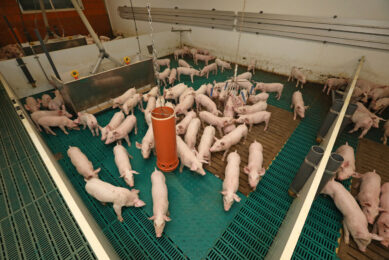Taking a closer look at dietary zinc oxide in piglets

At weaning dietary zinc oxide is used to combat diarrhoea which occurs as the intestinal ?microbiota changes. With associations to ?antibiotic resistance and the development of multi-resistant E. coli strains, the effect of zinc deserves closer examination.
Molecular methods have shown that the intestinal microbiota of pigs consists of dozens of different bacterial groups that include hundreds of species, which split into even more bacterial strains. As a whole, their metabolic potential and functional diversity is vast, their quantity outnumbers the total amount of cells of the animal body by at least ten-fold. It has been recognised that the intestinal microbiota is, among other functions, connected to the maturation of the immune system, it acts as a barrier against pathogen overgrowth and helps the animal conserve energy by using bacterial metabolites of hind gut fermentation.
Along the intestinal tract there are several distinct compartments that are inhabited by different bacterial groups. For instance, the stomach of suckling piglets is highly populated with lactic acid bacteria. Especially lactobacilli are known to form a barrier against pathogenic bacteria. Lactobacilli are also known to dominate the small intestine of pigs. Here, they interact strongly with the host epithelium and are said to help the immune system to mature. Although the small intestine is dominated by lactobacilli, other groups such as the enterobacteria (most known member in this group is Escherichia coli) and lactate fermenting bacteria (Veillonella and others) thrive in this habitat. The dominance of lactobacilli ends in the hind gut, where undigested nutrients and host material (sloughed epithelial cells, mucins, endogenous protein) are fermented by an immense diversity of strict anaerobic bacteria with an almost limitless potential to ferment a wide range of substrates.
Intestinal bacteria during weaning
Once established, the intestinal microbiota is able to adapt quickly to environmental changes like diet changes. Although it is generally harder to modify the established microbiota in adult animals, the young are still in the process of developing a steady bacterial profile and are therefore susceptible to modification. The weaning process is such a time for modification, a very dramatic time period not only for the piglet. Intestinal bacteria in suckling piglets were used to easily fermentable substrates in form of milk and host material (mucins, epithelial cells etc.). The sudden change to solid feed and drastic changes of most physiological functions in the intestine introduce a phase of rearrangement of the bacterial consortium that leads to chaotic results. This is the time for opportunistic pathogens to proliferate. Intestinal pathogens generally thrive under imbalanced conditions; it may it be the availability of substrates, reduced competition by other bacteria or morphological changes in the host epithelium/ immune responses that allows easy invasion. The visible result for the weaned pig is diarrhoea as a countermeasure of the animal against intestinal dysfunction.
A piglet the way pig producers like to see them. Often, dietary zinc oxide is used in pig nutrition to successfully combat post-weaning diarrhoea.Photo Hans Prinsen
Antibacterial effect of dietary ZnO
To counteract this problem, many countries use high doses (up to 3,000 mg/kg feed) of dietary zinc oxide in pig nutrition to successfully combat post weaning diarrhoea in pigs. The most probable antibacterial effect of zinc oxide is the free Zn2+ ion, which diffuses into the bacterial cell and acts as a radical. Although bacteria need trace amounts of zinc as co-factors to maintain their metabolism, toxicity of Zn2+ ions (and other heavy metals) is of much greater concern for them. Bacteria have evolved different mechanisms to counteract increased intracellular zinc concentrations. Generally, Gram-negative bacteria such as enterobacteria rely on proton-cation transporter systems, while Gram-positives such as lactic acid bacteria use P-type efflux ATPases.
Zinc oxide is highly insoluble at physiological pH, but under acidic conditions as found in the stomach of pigs, zinc ions are generated. In fact, more than 50% of the total zinc oxide can be present as free inorganic zinc ions in the stomach of weaned pigs. The stomach can thus be called the starting point of the regulating effect of the toxic Zn2+ ion on the intestinal microbiota.
However, the surface effect of the ZnO crystal may also play a role and therefore the physical form of ZnO is an important factor to be considered. Indeed, medical instruments coated with zinc oxide have been in use for a long time. The different physical appearances of ZnO are also a result of different processing of raw materials: the so-called ‘Waelz’ process yields about 40% of ZnO (termed ‘feed grade’) with considerable amounts of other heavy metals such as cadmium, while a hydro sulfide process leads to much higher yields (90%) and thus drastically diminishes contamination with other metals.
Differing concentrations of ZnO
A high concentration of dietary zinc oxide represents a drastic impact on the intestinal microbiota. Diverse effects on the composition of many bacterial groups were noted in deep sequencing studies. The most pronounced effects were visible one to two weeks after weaning. Furthermore, the composition of the intestinal microbiota was most drastically changed in the stomach and small intestine, while the hind gut showed less variation compared to low zinc diets.
The most notable consequences were: a lasting reduction of dominant Lactobacillus species and consequently a shift in the composition of lactic acid bacteria towards heterofermentative species (Weissella, Leuconostoc, Streptococci); a drastic increase of clostridia and an increased diversity of enterobacteria. A direct inhibition of E. coli as a member of the enterobacteria is not observed after two weeks application in several studies on this topic. The main effect regarding reduction of enterobacteria is confined to the first week after weaning. Actually, a more detailed report showed that a reduction of E. coli is already visible on the third to fourth day after weaning, depending on feed intake.
Changes for bacterial groups are most often correlated to the amount of the free inorganic Zn2+ ion, but much less to protein bound zinc and not at all to total zinc concentration. Therefore, it is highly probable that indeed the free inorganic zinc is responsible for the antibacterial effect.
While the composition of the microbiota gradually approaches ‘normal’ conditions in pigs four weeks after weaning, a lasting effect is visible for metabolite production. Prolonged use for three to four weeks after weaning reduces the short chain fatty acid production in the hind gut. This may be a negative effect of zinc oxide, as the pig uses these metabolites for energy conservation.
Increased zinc concentrations
The bacterial potential for adaptation to increased zinc concentrations is already visible after the first week of zinc oxide application. Experiments with intestinal contents have shown that bacteria from pigs fed a high zinc diet are better adapted to grow in media containing high zinc concentrations than bacteria from pigs fed low zinc diets. Most notably, enterobacteria were the most versatile, i.e. most adaptive bacteria in this process. This effect is only visible during the first two weeks after weaning.
As post weaning diarrhoea is often induced by pathogenic E. colistrains, it is generally believed that one direct effect of zinc is the reduction of these pathogenic strains. However, consistent results from different research groups regarding important bacterial groups after two weeks application of zinc oxide showed a decrease of lactobacilli and an increase of clostridia. No changes were observed for enterobacteria, except for an increased diversity in this bacterial group. Only directly after weaning, an inhibiting effect on E. coli can be noted.
The good, the bad and the ugly
If the ‘good’ lactobacilli decrease, the ‘bad’ clostridia increase and the ‘ugly’ enterobacteria are unchanged, how can we explain the decreased diarrhoea after weaning?
We have to differentiate. Yes, lactobacilli are considered beneficial, but they are not alone in the intestine. No, clostridia are not bad, only a tiny fraction of all clostridia are pathogenic. Clostridia are a whole class of highly diverse bacteria and in fact, hind gut fermentation in the pig mainly relies on the class of clostridia. Finally, the ugly enterobacteria are normal inhabitants of the intestine. Similar to clostridia, there are a few black sheep in the family that give the whole group a bad name.
So, what are the enterobacteria good for? They can regulate those pathogenic members among them that are unwanted, i.e. that lead to diarrhoea in weaned pigs. The pathogenic strains inhabit the same niches, ferment the same substrates and need the same growth factors as non-pathogenic enterobacteria. An increased diversity of established enterobacteria leads to increased competition for ‘newcomers’ and as a result the colonisation potential for pathogenic strains decreases. But there is a drawback to this effect…
A word of warning
Associated with the use of ZnO in weaned pigs there is an increase in antibiotic resistance. Recent reports have shown this for intestinal enterobacterial tetracycline, sulfonamide and quinolone resistance as well as for methicillin resistance in Staphylococcus aureus in the nasal cavity in pigs. Furthermore, high dietary zinc diets also lead to the development of multi-resistant E. coli strains.
The molecular reasons for this effect can be found in co-resistance, which is defined as the close genetic proximity of two or more genetic elements encoding for resistances. This is already known for zinc- and tetracycline resistance as well as for the zinc- and methicillin resistance in S. aureus. In enterobacteria, these genetic elements are conveniently located on plasmids which can be easily spread. Zn2+ ions introduce an environmental stress and stress increases plasmid transfer in bacteria as a safeguard reaction against extinction. Thus, normal E. colistrains may be converted to resistant strains. The longer the environmental stress lasts, the higher the probability for the development of resistant strains. Indeed, close monitoring of enterobacterial tetracycline, sulfonamide and quinolone resistance genes showed that the increase in antibiotic resistance started to arise one week after zinc application.
Administering zinc oxide effectively
Overall, it seems that zinc oxide is most active during the first week after weaning. The collateral damage for this general bacterial reduction is the lower colonisation rate with pathogenic bacteria, among them diarrhoea inducing E. coli. Later, effects on pathogenic E. coli are most likely due to increased competition from an increased diversity of enterobacteria.
Restricting application
The antibacterial effect diminishes as the animal ages. The lasting reduction of lactobacilli as well as reduced hind gut fermentation may prove to be negative regarding the resilience of the animal against bacterial infections later in life and loss of energy from fermentation, respectively. Correlation of zinc use and antibiotic resistance development is an issue to be monitored closely. Already in the last millennium it has been proposed by several authors that the application of zinc oxide should be restricted for two weeks after weaning. The results of the last decade on this topic clearly point in the same direction.
[This article was featured in Pig Progress magazine no. 2 – 2015 – to see more published articles go to the digital magazine]











